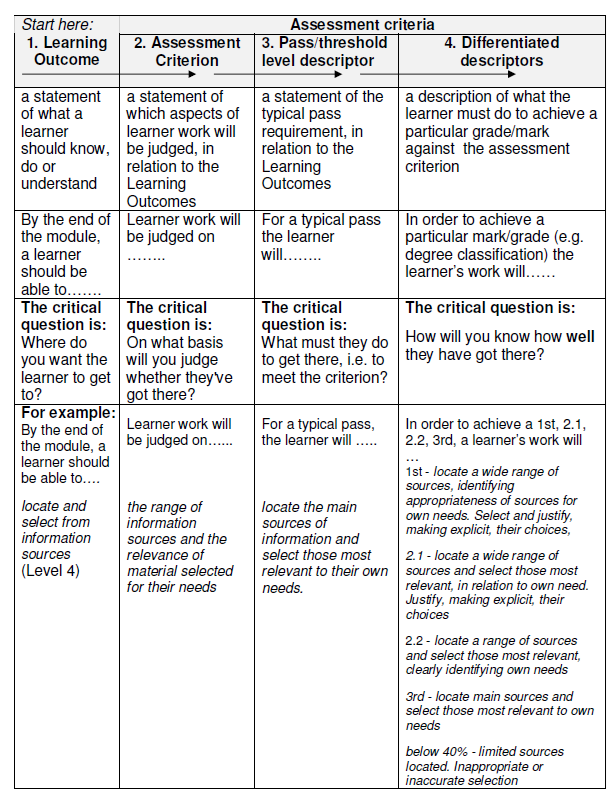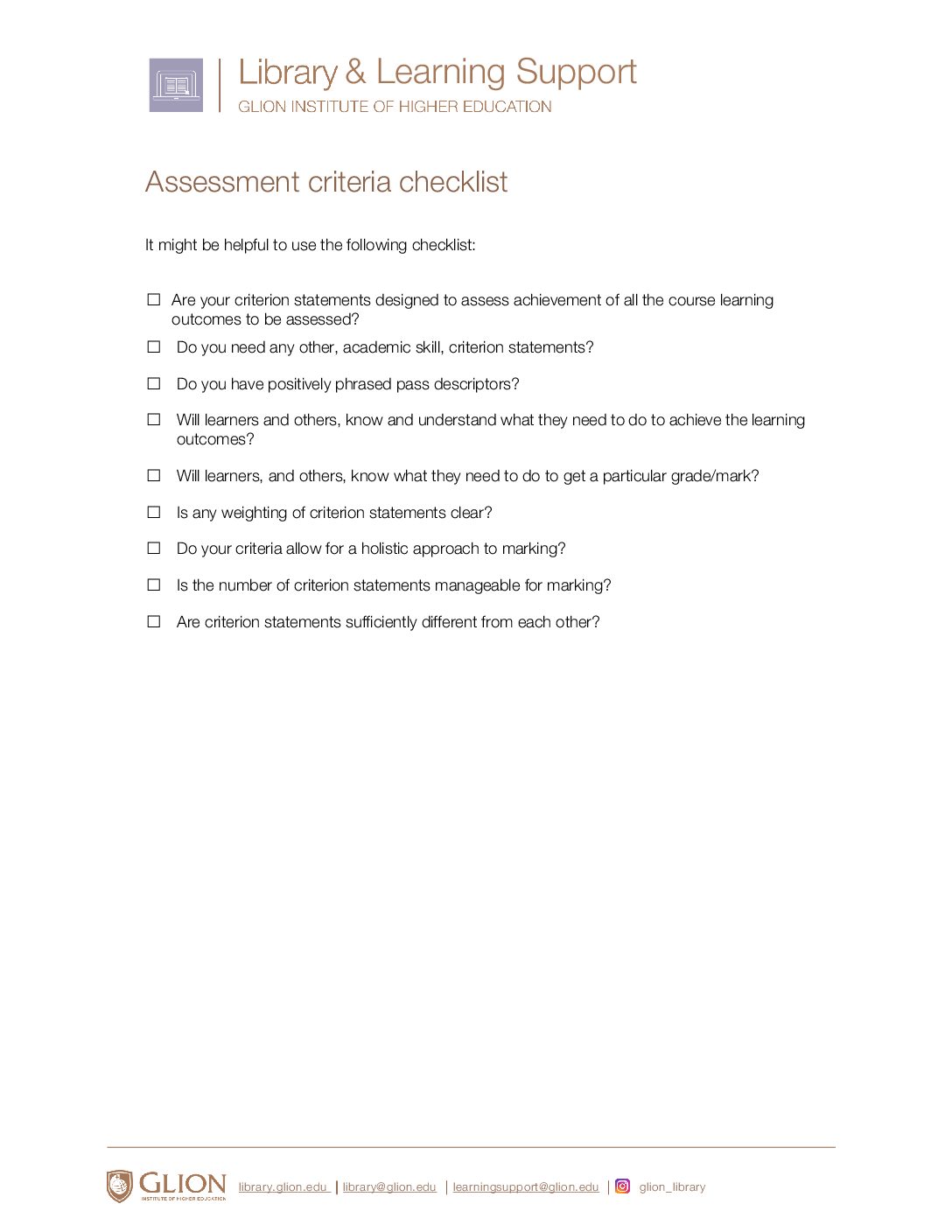How to write assessment criteria
BACKOverview
The over-riding principles in the design and use of assessment criteria are that students, teachers, and other stakeholders should clearly understand:
- how and why marks/grades have been awarded
- that they have been awarded fairly.
Students are assessed on how well they have met the learning outcomes of a course, and therefore, the assessment criteria must be designed to assess just this. In other words, assessment criteria indicate how the student’s work will be judged in relation to the learning outcomes.
There should also be a clear indication of the level required to pass – the threshold level (expressed in positive terms).
Further information about what is required to achieve a particular grade/mark should be expressed in a more detailed breakdown of each criterion. Differentiated descriptors articulate how the level of achievement will be judged. The criteria and differentiated level descriptors can be conveniently organised into a grading rubric
Key features of good assessment criteria
Assessment criteria should:
- relate directly to the course learning outcomes
- indicate what is required at a pass level, (the threshold level) in a positive way
- help students know what they need to do and how to do it
- help students understand what you expect at differing levels of achievement
- be understandable to all stakeholders
- be manageable in number
- be distinct from each other
- be seen as an indication of achievement rather than an exact measurement.
Flow chart
When developing criteria, you might find it helpful to think of them in terms of a flow chart, linking one stage to the next:

Steps to defining assessment criteria
5.1 Start with the course learning Outcomes. The criteria should cover all the course learning outcomes and there is a very close relationship between them and the assessment criteria – many of the words will be repeated. The difference is that the assessment criteria describe the level of performance required, often through the use of more evaluative words e.g. thorough, clear, accurate, wide ranging, rigorous, main, meaningful, well-reasoned. (You may need to further clarify your meaning of these words.) Your course learning outcomes should be expressed in terms of what is required to pass the course (the threshold level).
Learning Outcome at Level 6: You will be able to critically apply costing methods to make informed decisions within the hospitality industry.
Assessment criterion: You will be judged on…” the accuracy of your application of costing methods and the validity of your evidence-based decisions’’.
Pass level descriptor: For a typical pass, you will ….’ Accurately use costing methods to produce reliable data and use this data to make appropriate decisions.
5.2 Identify your own implicit criteria which influence your judgement.
When you’re marking learners’ work, what features influence your perception – either positively or negatively? What do you value? Tutors may often have implicit criteria – e.g. style, presentation, integration of sources. To ensure equity and parity, learners need to be clear about all the criteria used to mark their work. You could select 3 pieces of work, ranging from fail to excellent. Describe those characteristics which denote the level of achievement and use these to help you develop descriptors.
5.3 Look at existing examples of criteria.
You may be able to save much time and energy by looking at examples of criteria to modify and adapt. You may find it helpful to use others’ words, if they express and articulate your thoughts. You may also be able to eliminate some examples as inappropriate for your needs. However, you must bear in mind that your assessment criteria MUST relate to the learning outcomes for each individual course.
5.4 Identify the differences between grades/marks.
Having decided on the aspects to be judged (i.e. the assessment criteria), the next question is ‘What will a learner need to demonstrate in order to achieve a specific grade/mark?’ (i.e. the standards or the differentiated descriptors). The use of a grading rubric grid can be particularly useful. Grading rubrics can:
- increase transparency for all stakeholders.
- facilitate moderation.
- be useful if there are several course teachers/
- be built into the course Moodle page, making grading faster.
- be particularly useful in providing the basis for giving feedback.
Tips for developing grading rubrics:
Developing grading rubrics takes time – to articulate your thoughts, to select appropriate and meaningful language, to clarify the progression from one grade to another, and to check out understanding with others. Nevertheless, it is a valuable and important exercise.
- It helps to start by developing the criteria for the 50% column – what is the minimum, threshold standard required to pass? Once this is articulated, you can build up and down the columns.
- Phrase the 50%/pass descriptor in positive terms. Words such as ‘inadequate’, ‘limited’, ’inaccurate’ generally describe work which does not meet the Learning Outcomes.
- Work with a colleague on the grading rubric – discussion helps articulation of difficult ideas.
- As you move up the grades, avoid introducing new criteria into the descriptors. The main aspects of the criterion should follow up the levels, with an increasing demand in that particular aspect.
The following are some examples of ways you could move up the levels:
increasing the degree of autonomy required e.g. the level of independence or decision-making needed, initiative.
broadening the situation/context in which the learner applies the learning e.g. a pass might relate specifically to in-module teaching, whilst higher grades might draw on wider experiences/sources.
increasing the range/number of elements you expect the learner to use e.g. using a wider range of presentation techniques, combining more problem-solving techniques, using a combination of skill elements.
Areas to consider when developing criteria statements
When developing assessment criteria, it may help to consider the following:
- How many criteria will you have? Using too many criteria can make the marking process complex and lead to a more rigid approach e.g. more than 7or 8 per module may be difficult to work with. Efficiency and effectiveness are increased by not having too many.
- How many grades of achievement will you have? A 5-point scale is normally broad enough to mark the full range of learner work. Having too many levels may result in an averaging out of the marks, so that, for example, all learners are awarded 55%. Research has shown that reliability of marking between tutors is increased by using a smaller number of bands.
- How will you relate them to the course learning outcomes? Will each criterion relate directly to each individual outcome, or will you group some outcomes together by theme? Several Learning Outcomes could be linked by a single assessment criterion.
- How will you avoid telling the learner what to do? When writing criteria, you need to ensure you are not telling learners precisely what to include in their assignment, e.g. an assessment criterion should be ‘Your work will be judged on the relevant application of key theories’, rather than ‘Your work will be judged on their reference to the theories of X, Y and Z’ It is useful to think of the challenge that you are presenting to the learners, and ensure that your criteria do not diminish that challenge.
- How will you avoid writing criteria which could restrict or restrain learners? Creativity/spontaneity/originality should be rewarded. Your assessment criteria should be explicit about this. This may be particularly important at FHEQ levels 6/7.
- Weighting criteria – What is the relative importance of each criterion – are they all of equal worth or do you value some more highly? A list or grid of assessment criteria with grades of achievement may give learners the impression that all criteria are of equal value. If this is not the case, you need to illustrate and clarify the relative importance of different criteria. This will influence students’ decisions about how to spread their time and effort.
- Aggregated scores – How can you ensure you maintain a holistic approach to assessing the work, and avoid reducing a complex issue to segments, with aggregated numerical scores? Each criterion should work together with others and so contributes to the whole picture, avoiding a reductionist approach. Options are to include a specific criterion relating to overall competence, or to weight criteria appropriately. Again, it is important to acknowledge that criteria provide clear, but not exact indicators for assessing. If criteria are over specific or too numerous, there could be a danger of constraining both the learners and yourself.
- Criteria for exams – Whatever the mode of assessment, there is a need to be explicit about the criteria used to judge the work and to link these to the Learning Outcomes which are being assessed. This is equally important when using examinations as the chosen assessment mode.
Assessment criteria checklist
It might be helpful to use the following checklist:
Using criteria for giving feedback to students
Timely and targeted feedback is important for learning and progression. This time-consuming process may be made more efficient by focussing the feedback around the criteria.
Options could be:
- Tell the learners in advance on which criteria you will be giving feedback.
- Return a copy of the assessment grid/criteria sheet to the learner, with their level of achievement highlighted. It should be noted that this on its own does not suffice as feedback, and individually tailored comments should accompany any such sheet or rubric.
- Peer to peer or self-evaluation: As a practice activity, students review their own or each others’ work and give feedback using the criteria – with support from the teacher.
Self-evaluation and peer feedback
How can students evaluate the quality of their own and others’ work/achievement?
Independent learners need to develop skills of self-evaluation and reflection, as key academic and professional skills. Learners need guidance, support and practice in:
- making informed evaluation of the quality of their own and others’ work
- providing thoughtful and constructive feedback.
Clear and understandable assessment criteria are essential for learners to make informed and valid judgements in self and peer assessment, and they need to openly discuss and debate the meaning and interpretation of the criteria.
Useful strategies include:
- self-assessment – learners undertake a self-assessment exercise, mark their work in accordance with the identified criteria, submitting it with their work.
- learners suggest ways in which they could improve upon their mark to provide feed forward for subsequent learning tasks.
- using pairs – learners explaining their thinking to each other helps clarify
- the learner group identifies and negotiates their own criteria e.g. for a presentation. Individually, learners identify 5 criteria, then share, discuss, and agree with a partner. These criteria are then posted up and a group discussion clarifies meaning and merging of ideas. The group may also prioritise the criteria. This helps learners identify what makes good performance.
- learners (individually or group) generate and add their own criteria to those the teacher has identified.

